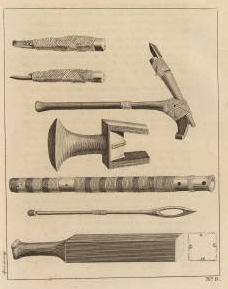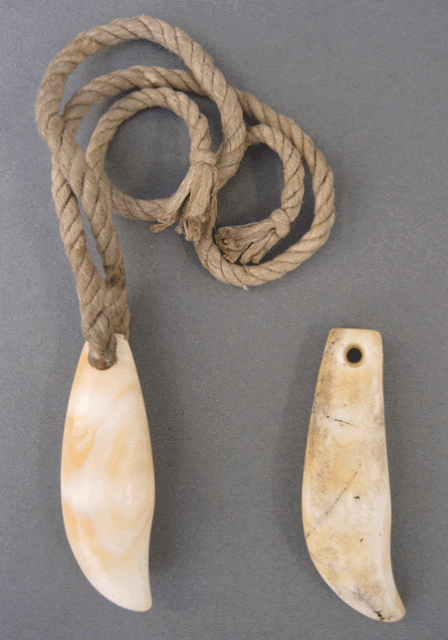Last week, Caroline Cartwright from the Department of
Conservation and Scientific Research at the British Museum came to visit
us at the Pitt Rivers. Caroline
is an expert in the identification of plant fibres, and she will be
carrying out some ID work for the Conserving 'Curiosities' project.
In a previous blog post I mentioned that the investigation
of the materials from which objects are made can give us information
about where they come from - even though the Forster collection in
particular is relatively well documented, there is still confusion about
this. Even when we know for sure where an object comes from, like this unique barkcloth from Easter Island (Rapa Nui), some of the materials still remain unidentified.
 |
| 1886.1.1250 Barkcloth, Easter Island |
The barkcloth has decorative bands of plant material sewn
across each end - said to be a rush that grows in the bottom of the
extinct volcano (Rano Kau) on Easter Island. A cord made from plant fibre was used to sew the layers of barkcloth together at intervals - almost like quilting.
 |
| 1886.1.1250 Detail of stitching and fibre |
Other material that Caroline will look at includes plant fragments found in this headdress.
 |
| 1886.1.1685 Tamau Headdress, Tahiti |
This is Forster No. 40, 'The Tamow, or headdress of plaited hair.' Considered to be a 'lost' Forster object, it was found under the bindings of the Tahitian Mourner's costume.
 |
| The tamau as found on the headdress of the Mourner's costume |
The tamau was made of many metres of plaited human hair, made to form a continuous length. It was worn by women as they danced, and the centre was filled with flowers.
 |
| A young woman of Otaheite Dancing, after John Webber |
George Forster, in 'A Voyage Round the World', saw a dance
performance in the Society Islands in September 1773. He talks about
the dress of the dancers, which included 'Poyadua (Poedua), the fair
daughter of the chief Orea'…
'The neck, shoulders and arms were left uncovered, but the
head was ornamented with a kind of turban, about eight inches high,
made of several skains of plaited human hair, which they call tamow. These
being laid above each other in circles, which enlarged towards the top,
there was a deep hollow left in the middle, which they had filled up
with a great quantity of the sweet-scented flowers of the (gardenia)
cape jasmine. But all the
front of the turban was ornamented with three or four rows of a small
white flower, which formed little stars, and had as elegant an effect on
the jetty black hair as if it had been set with pearls.'
William Ellis also described a group of dancers on Tahiti in 'Polynesian Researches', published in 1831.
'The daughters of the chiefs, who were the dancers on
these occasions, at times amounted to five or six, though occasionally
only one exhibited her symmetry of figure, and gracefulness of action. Their dress was singular, but elegant. The head was ornamented with tamau, a fine and beautiful braid of human hair, wound around the head in the form of a turban. * A
triple wreath of scarlet, white and yellow flowers, composed of the
aute, the fragrant gardenia, or Cape jessamine, and the baslaria
laurifolia, tastefully interwoven, adorned the curious head-dress.
* Mr Barff, to whom I am indebted for the principal part
of this account, procured a head-dress of this kind, containing one
hundred fathoms of the finest braided human hair.'
One hundred fathoms is about 180m. It is likely that the tamau in the Pitt Rivers collection contains closer to 1000m of hair.
Fragments of plant material were taken from this and
several other objects, and we hope that with Caroline's help some of the
questions that people have been asking about the Cook-voyage
collections for several hundred years might finally be answered.












































